Winter Trout Fishing: 31 Best Guide Tactics And Tips
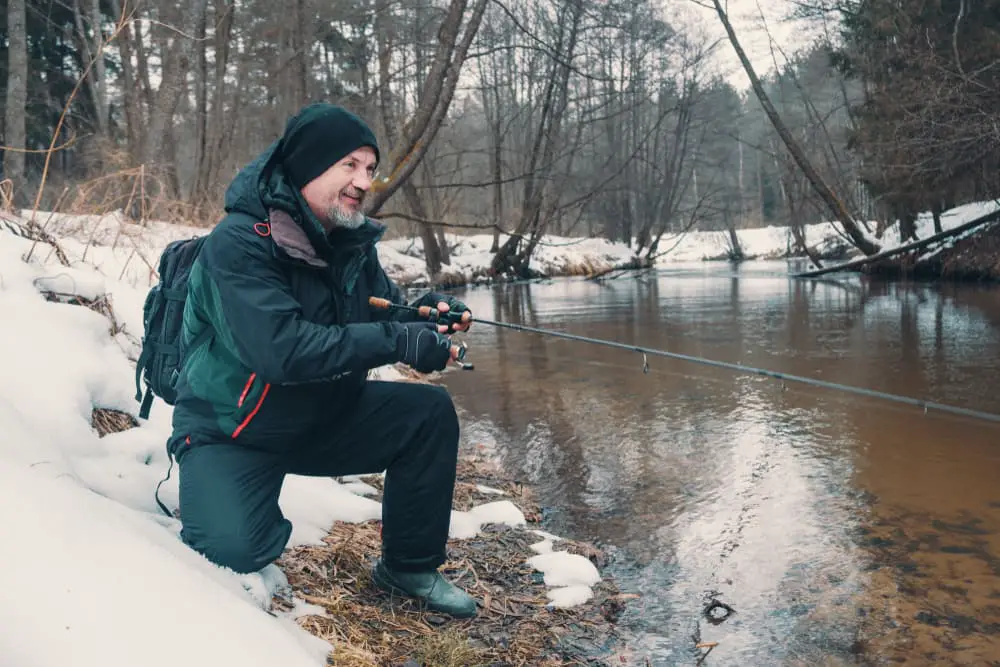
Even though streams and rivers seem lifeless during the winter season, there is still plenty of life below the surface, and trout fishing can be very good,,especially if you use the same methods that I use when guiding in the winter.
Winter trout fishing can be very good if you slow down your presentation, fish deeper using smaller flies and baits, and fish in areas that concentrate the trout. Although some surface fishing is possible, most trout fishing in the winter is done subsurface using nymphs, streamers, eggs, and worms.
About Winter Trout Fishing
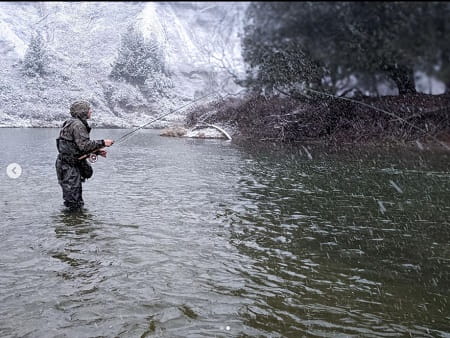
Trout fishing in the winter has its challenges, with less active fish, ice-cold water, less or no bug activity, and less food. Trout will also only feed selectively during certain times of the day.
Anglers that change and adapt their methods and their baits can still catch a lot of trout.
Things like water temperatures, feeding patterns, feeding windows, your flies and baits, and the tactics you try can all play a huge role in catching trout in the winter. So how do the guides do it? Let’s find out.
Dress For Winter
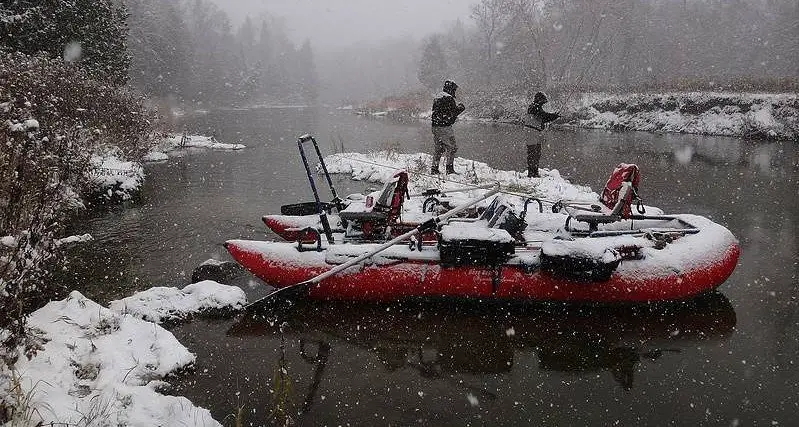
The cold keeps many anglers off the water, but I fish all winter and have figured out what it takes to stay warm when standing in ice-cold water and below-freezing air temps for many days.
These are the tips we provide our clients and friends to help them stay warm.
- Layers are the most important thing for keeping you warm.
- Use technical base layering that traps heat and wicks away moisture.
- Use better waders – Some waders are better in ice-cold water.
- Upsize your boots – Wearing wading boots that are two to three times bigger allows more blood flow and allows you to add thicker socks without squishing your feet.
- Use good fishing gloves – It’s touch fishing in gloves but many anglers will use Merino Wool half-finger gloves, which enable you to feel the rod and reel but still keep your hands warm.
- Wear a warm hat – A wool hat that covers your ears can keep your entire body warm since they say most of your body heat is lost through your head.
- Use A good outer layer wading jacket or coat.
- Use hand and feet warmers.
See Best Waders For Winter Fishing.
Winter Layers For Trout Fishing
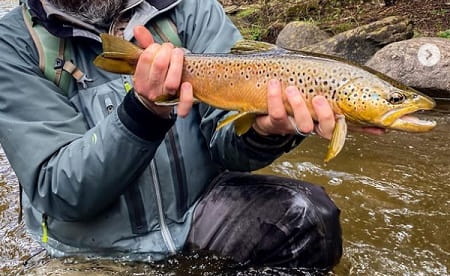
Standing on the banks or balls deep on a trout stream in the winter can make you cold fast. Of the best things you can do is layer appropriately.
With layering, you can remove some layers if you start to get too warm.
I am generally wearing 3 to 4 layers and this will keep me warm even on the coldest days.
My recommendations for very cold temps are:
- Base Layer – Your base layer is a thin layer of the socks, pants, and a shirt that is good at trapping heat and wicking away moister
- Mid Layer – The mid layer is a thicker base layer made of good thermal material.
- Third Later – A third layer would be a thick pair of thermal socks, thermal pants, and a thick hooded sweater (I always wear a hoodie)
- Outer Layer – This would be your waders and your wading jacket. Now that you are prepared for winter fishing, now let’s talk trout fishing.
For my guide tips on how I and other guides stay warm, check out my page Fishing In The Winter – Stay Warm With These 10 Tips.
The Best Water Temperatures For Trout Fishing In Winter
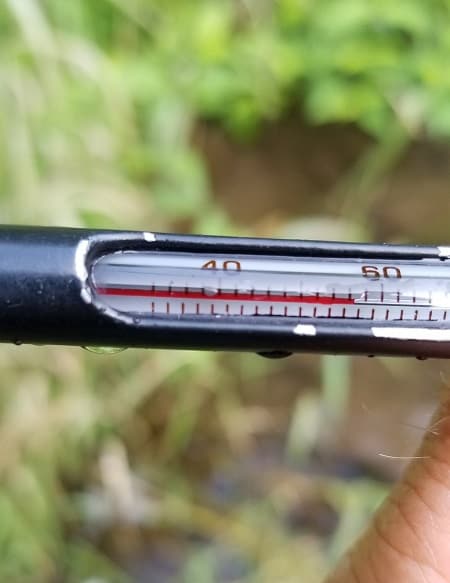
Often, the key to catching trout in the winter is understanding how water temps affect trout feeding and holding patterns.
Even though trout try to preserve their energy during winter, trout still have to eat and they will feed selectively with short feeding windows that are often based on stable water temperatures or rising water temperatures.
Often, both the aquatic insects and the trout will start becoming more active as the water temperatures rise. This rise can happen daily, weekly, or seasonally.
All it takes is a few degrees of increase to see a dense midge hatch with adult midges on the surface, which is an opportunity to dry fly fish.
Daily water temperature increases will happen on many rivers that stay ice-free, especially on sunny days. It’s these days when trout will opportunistically feed on insects such as nymphs and small midges.
Anglers who know how to predict these warmer water times will catch more trout and I’ll expand on this more below.
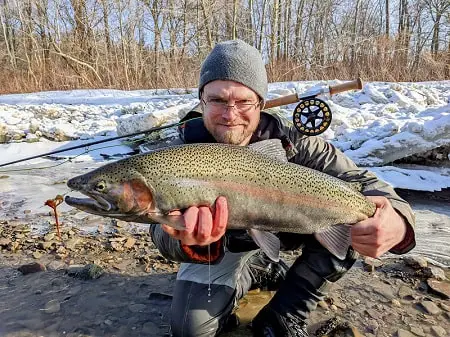
Trout are cold-blooded so fast dropping water temps will often shut them down which makes catching fish very difficult.
It does not matter if they are brown trout, brook trout, or rainbow trout, they all react to fast drops and fast rises in temperature the same.
If the temp of the water is slowly increasing you could be in for some good fishing.
The Best Time Of Day
Now that you understand how temperature affects trout, you can plan your winter outing better.
Sleep In For More Trout
Late fall, all winter, and early spring, I start my guide trips later in the day. This is opposite to trout fishing in the summer months when I want to be on the water as early as possible.
There is no need to wake up early since mornings have the coldest water temps of the day and that means the least active trout. The reason for this is that the water temps will continue to drop overnight.
The best time to get out to the river is late morning and early afternoon after the water temps have stabilized or the sun has had a chance to warm up the trout stream a degree or two.
I usually get on the river between 10:30 am and 2 pm since this is when the river is at its warmest, and the trout are the most active and will be most likely to feed.
This is especially true on sunny days when the river is exposed to the sun a lot.
Anglers will also feel more comfortable fishing at this time of day so they can focus on fishing and not be distracted by cold hands and feet, and you will likely be able to stay out longer.
Trout Fishing Is Better On Warm Days
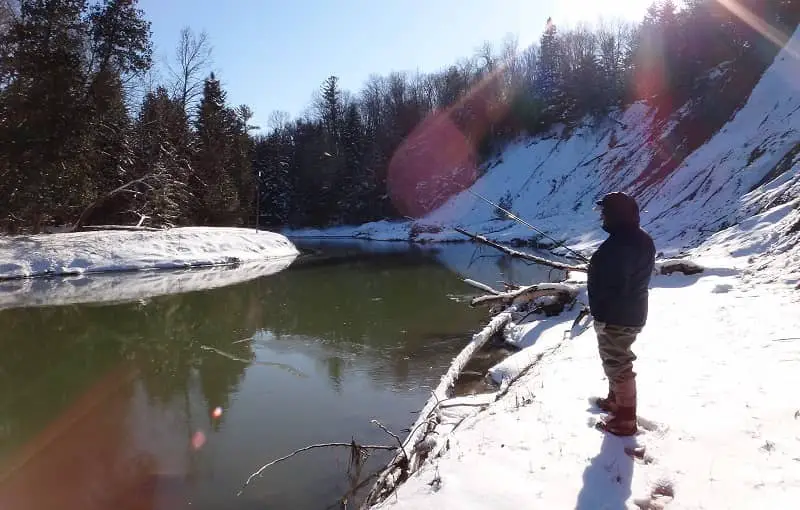
Watch the forecast and choose your fishing days wisely. Look for warm days or stretches of warm weather.
Longer stretches and warmer days are when the best bug hatches will occur, and this is when you are most likely to see fish rising.
On the flip side, watch the forecast and avoid those cold and cloudy days that will shut them down and make them go lock-jaw.
Where Trout Hold And Feed In Winter
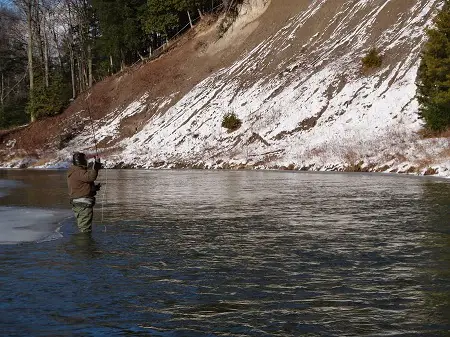
It might be challenging to locate trout from December to March because they will not always be where you catch them during the warmer months.
Trout will most likely concentrate in a few pools that have exactly what they need to survive the extreme conditions of the winter. These are often referred to as a winter refuge.
Find a few winter refuges on your local river and catching fish will become easier. You will also find big fish and small fish mixed in the same pool, especially on smaller streams.
When trout fishing in winter, check the following places first:
- Logjams and Structure- Deeper pools with logjams often concentrate winter trout, and I have seen a trend showing the pools with structure will concentrate more winter trout than pools without.
- Deep water pools that are over three feet deep – deeper pools offer trout security and protection from predators, and the faster current, and deeper and bigger pools have more food than shallower areas.
- Gentle currents – slow water can be a great place to find feeding winter trout, especially if there is enough depth for them. Tailouts of bigger pools can be a great place to fish for winter trout.
- Spring creek mouths or underground springs in the river – Ground water upwellings and spring creeks are often warmer than the main river, and the trout will prefer this warmer water. Areas below upwellings and where spring creaks enter the main river can be hotspots for trout.
- Downriver – A little-known phenomenon is that many trout will migrate dozens of miles down a river to winter over in the bigger deeper pools of the middle reaches of a river before the river gets too cold.
During the winter, you are less likely to find fish in faster water or shallow water.
Slow Down Your Presentation
When trout fishing in winter, you will need to slow down when presenting your bait or flies to less active trout.
Trout are not going to chase after their food since they need all their energy to survive the winter. The less trout have to work for your bait and the closer the bait is to them the more likely they are to hit it.
Streamers and lures can be good, just slow down the retrieve as much as possible. Anglers will even dead drift streamers with good success.
Fish Deep
Because most or all of the trout will be close to the bottom where the water is warmer and the current is slowest, you will need to fish your flies and baits deep, and then fish them slowly.
In many of my articles, I talk about how speed control is one of the most important things to do well when presenting a bait or a dead drifted fly, but it’s even more important in the winter months.
Best Water Conditions for Winter Fishing
Often, a trout stream in winter will be low and very clear, and that is okay if you know how to fish in low clear conditions.
Ice Cover
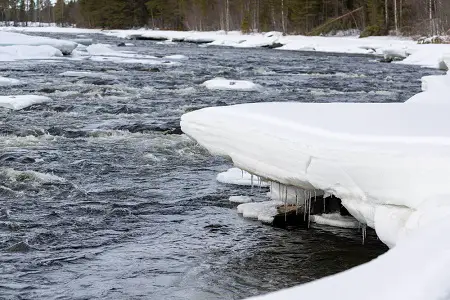
Surface ice in rivers provides overhead cover and more stable river conditions, and it can even act as an insulator to keep the river temps warmer.
Some trout will hold under ice shelves and even feed along them. An ice shelf that protrudes part way out into the river can also be a feeding lane due to floating insects concentrating along the edges.
Best Fishing Methods For Catching Trout In The Winter
Just about any fishing method that works in the spring will also work in the colder months of winter.
Winter Fly Fishing
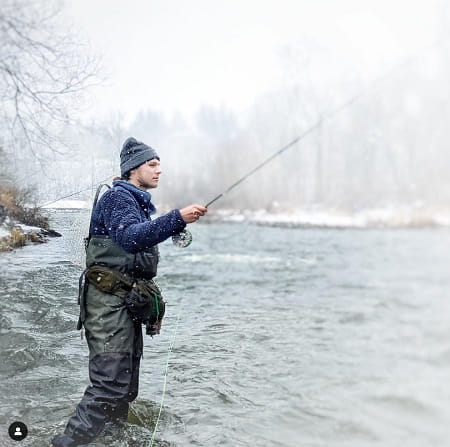
Fly fishing provides anglers with many options.
All the fly fishing methods will work at this time however you may need to tweak your presentation a bit and make sure you use the right fly.
Try these winter fly fishing tips:
- The downside to fly fishing in the winter is that when fly fishing, anglers tend to be grabbing the line a lot and that line is wet and can make your hands wet and very cold. Fish a short fly line and leader so you don’t touch the fly line often.
- Whether you are fly fishing wet flies, dry flies, nymphs, or streamers, fish them all slowly.
- Dead drift is best and so control your speed to try to achieve the slowest drift possible.
- Floating fly lines are best in winter.
- Fish sunny days if you want rising fish and some good dry fly action.
For more in-depth information, check out my latest article Winter Fly Fishing: Tactics and Tips For Guides.
If you happen to fish for steelhead too, see Winter Steelhead Fishing Tactics Used by Guides.
Winter Nymphing Strategies
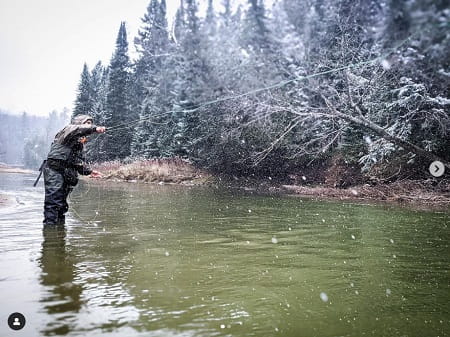
Nymphing is going to usually be your most effective fly fishing method in the winter and Strike indicator fishing is eveyones go-to method.
Strike indicator fishing can be the most effective way of fishing deep slow water.
Keep your strike indicators small and use as few weights as possible. This will prevent spooking fish and often you won’t need a lot of weight to fish slow deep pools.
Tight Line Nymphing and Euro Nymphing
Consider Euro nymphing in water less than 6 feet deep or when a strike indicator is spooking fish. In deeper faster, water methods like Czech nymphing or Polish nymphing are best.
In slower water consider Spanish nymphing.
For more on this very effective method check out my article Euro Nymphing: Guides Perseptive.
Streamer Fishing
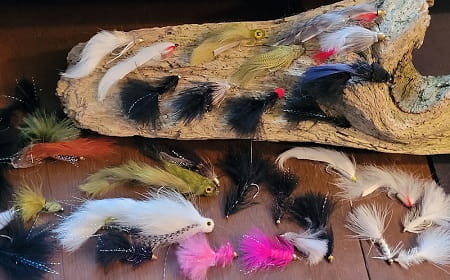
Streamer fishing can be very good once the water has warmed a degree or two.
Slow your stipping down and use smaller streamers to start and gradually get bigger.
For more on the streamer fishing methods I use for trout and steelhead, check out Streamer Fishing Methods.
Try dead-drifting a streamer
I like smaller-sized streamers like white Zonkers, Bunny Muddlers, and Micro Buggers dead drifted near the bottom.
Float Fishing
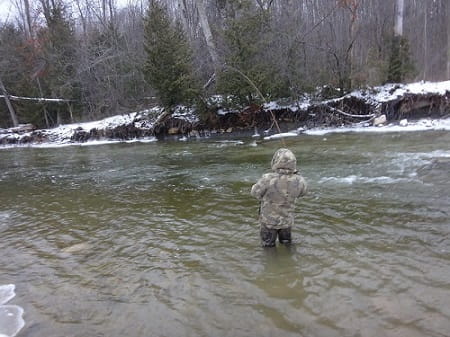
Drifting your bait or flies deep below a float is often the most effective way to catch fish in the winter.
Float fishing with the right floats and done properly allows you to fish deep and slow.
Float fishing is best done in water deeper than 3 feet deep.
It’s not that hard to get better at float fishing and I give you my secrets to e better on my page Float Fishing For Trout.
Drift Fishing Methods
If you need to fish in water shallower than 3 feet deep, or pocket water, the most effective way is bottom bouncing with bait or flies.
If you are fishing very deep and fast currents, consider the drift fishing method.
Best Baits for Winter Trout

The key with any bait is to fish it deep and slow.
Use only good baits and avoid ineffective baits like corn or imitation baits.
See more of the best baits at Best Baits For Trout That Guides Use.
The best baits for winter trout are:
- Spawn sacs, also known as roe bags
- Skein
- Beads
- Live and plastic trout worms
- Live or dead minnows
- Grubs, maggots, mealworms
Best Flies For Cold Water Trout
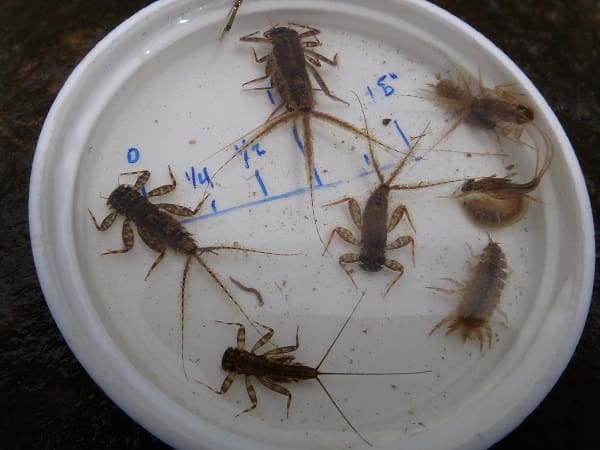
Pay attention to the river and if you see anything hatching, If not stick to small but common natural nymphs or dry flies.
Small nymphs will almost always outperform larger ones in the winter.
Best flies for winter trout:
- Pheasant tail nymphs
- Caddis Larva
- Little black stoneflies
- Zebra midge, green midge, black midge, and red midge patterns can all be great.
- Scuds – Scuds are in any river year-round and can be very good in the winter.
The nymphs most river guides use and recommend for trout fishing in winter are will resemble insects that are most active like mayflies and stoneflies. Some of my most effective winter trout nymphs are:
- Sexy Walts and Regular Walts Worm – Size 14 to 18
- Polish Pheasant Tail Nymph (size 16 to 20)
- The Frenchie Fly – Size 14 to 18
- Bead Head Copper John Nymph – Size 14 to 18
- San Juan Worm – 2 to 3 inches
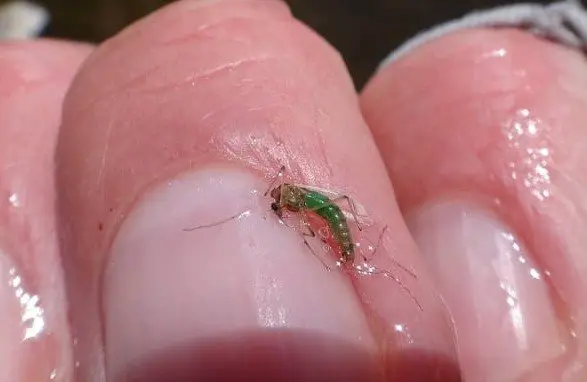
As far as dry flies are concerned, there are rarely many dry flies on the water during the winter months. However, there are times when you might see midges, tiny stoneflies, and blue-winged olive mayflies.
There are some good patterns online that will replicate these flies.
Try these:
- ICSI Midge (size 22)
- Griffith’s Gnat (size 20) – imitates adult midges on the surface.
Best Lures For Winter Trout
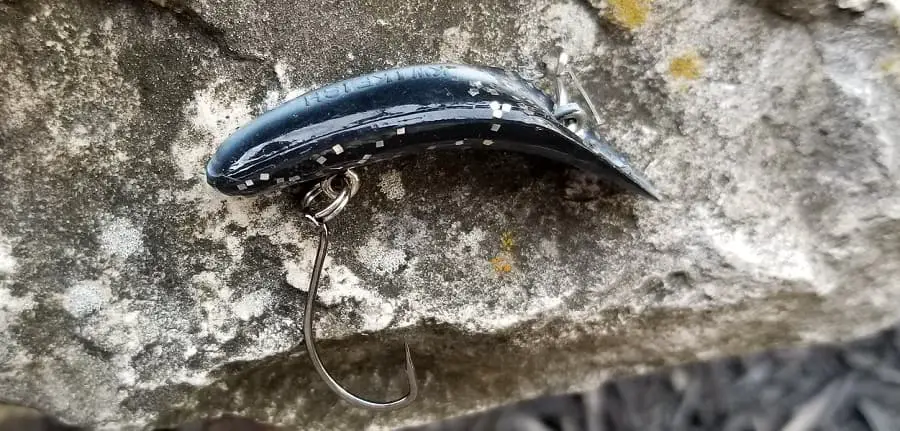
The thing with fishing lures in the winter is you need to use the right ones that work well in slower currents because trout in the winter can be lethargic and not willing to chase a fast lure.
Fish lures after the water has warmed a couple of degrees. Fish them on light lines.
Best Lures For Winter:
- Spinners
- Kwikfish and Flatfish: These are great plugs that have a wide enticing wobble even in slow currents and this can really attract trout.
- Jigs: I love jigs for winter trout because you can move the jig slowly along the bottom which is where the trout are feeding.
- Crankbaits – Slowly lowering a crankbait down into the deep pool can be a deadly effective method for winter trout.
to learn how to fish lures better and for some of the best lures to use, check out Fishing Lures For Trout.
Down-Size Everything
When I say size down everything, I mean your weight, flies, baits, indictors, tippets, leaders hooks, and everything in your entire leader system.
Light Leaders For Trout Fishing In Winter
Winter river conditions are usually low and clear so it’s important to use very light and long leaders that the tout will not see.
Because the fish are lethargic they don’t fight as hard so lighter leaders and tippets can be used.
I will go down to two pound test when trout are finicky in gin-clear water.
Use Stealth To Catch Trout In The Winter
As mentioned above, the river conditions in the winter are often very low and very clear and therefore it is important that you tread lightly and be as stealthy as you possibly can.
Stay behind the trout so you stay out of sight and move as slowly and quietly as possible. This will improve your success when trout fishing in winter.
Sight-Fishing in Winter
Spotting and stalking trout is the most effective strategy during the winter due to the low clear water.
I will often sneak up to deep water along banks or near log jams to see if I can spot any large trout.
Some of the biggest trout of the year are caught during the winter when flows are low and clear.
Polarized glasses are a must at any time of the year to help you see through surface glare, however, in the low clear water of winter, it’s very possible to locate big fish easier with good glasses.
Fish Tailwaters And Spring Creeks.
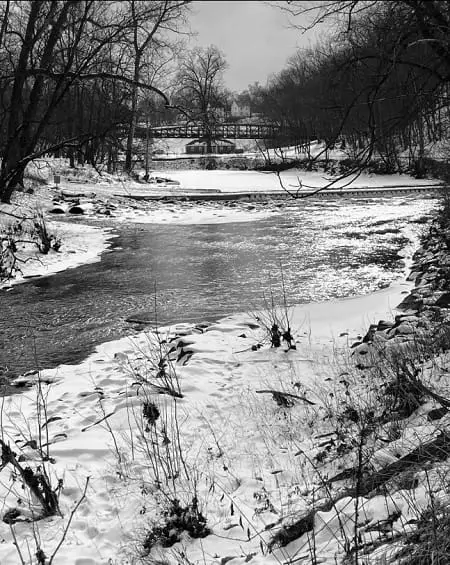
You will often have more success fishing spring creeks and tailwater rivers and below dams.
Groundwater often enters the river at around 55F, so spring-fed creeks with a lot of groundwater will rarely freeze and will stay warmer in the winter than other rivers.
These spring-fed creeks will fish better due to the more stable and warmer water temperatures.
Tailwater rivers are also great rivers for trout fishing in winter for the same reason, which is that they rarely freeze, and the water temperatures will stay more stable and warmer than other rivers.
This means more bug activity, more fish activity, and a better chance of catching some winter trout.
Tailwater rivers also tend to have higher trout populations due to stable water temperatures and better survival rates. There tends to be a lot more insects in these rivers and since there are more fish it’s easier to find trout.
Tailwaters are created by dams and often the warmest water in the winter is closest to the dam. Even in January, the river will be ice-free for many miles below the dam.
Below dams are also great spots, even on freestone streams during the winter because they tend to remain ice-free for longer.
Advantages and Challenges
Trout fishing in winter can be good, but it can also be challenging.
- Winter fishing offers year-round fishing.
- You will find solitude and miles of untouched streams, even in areas that have crowds in the spring. Often, you won’t see another footprint in the snow. January can often be the least fished month.
- With sporadic hatches, winter fly fishing can be very effective, even for dry fly anglers.
- The best fishing occurs in the late morning, so you can sleep in.
- Most fish are concentrated, so you can completely avoid all the fast water sections.
- Food sources are scarce, so the trout are hungry and more likely to eat a well-presented bait or fly.
Challenges of Winter Fishing
- A phenomenon known as anchor ice, which is ice that starts to form on the bottom of the river can create hazards when crossing and can cause more snags. You see this on freestone streams more often.
- Fishing in slush can be nearly impossible.
- Trekking through deep snow is sometimes required to get to the best spots.
- The slow metabolism of the trout can make them want to conserve energy and they eat less.
- Anglers who fall in are at high risk for hypothermia.
- Ice on the line and in the rod guides can prevent you from getting a good drift.
- Midge patterns are sometimes all the trout wants, and that can be tough for bait guys and lure anglers. FYI, you can fish a midge fly under a float.
Winter Fishing Safety
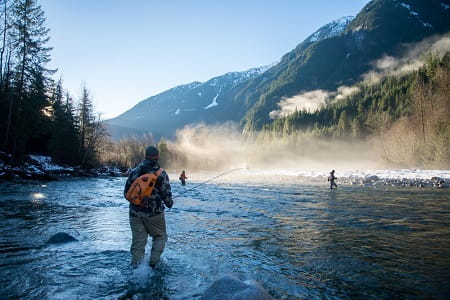
As a guide who is responsible for the safety of my clients, safety is a priority for me.
Even when I’m fishing for fun, I still play it safe, especially in the winter.
- Wading staff: These are great when crossing the river at any time of the year but they are also good on icy trails.
- Ice shelves: Ice shelves can be misleading and dangerous, but I see anglers going out on them all the time. I’ve also seen the ice break and anglers go down and deep. Getting back onto the ice shelf in the current can be tough, and if the current pulls you under, you’re dead. So avoid ice shelves.
- Ice cover: The current makes completely frozen rivers very dangerous with some sections of the ice cover thick and safe and a few feet nearby it can be thin and dangerous. Some light snow on top can hide soft spots in the ice. If you fall through the ice, you could be swept under the ice by the current. Do not walk across ice-covered rivers.
- Cleats: Get some strap-on cleats that are cheap, and they will help with crossing the river, wading on slippery anchor ice, and walking on icy trails.
- Fish with a buddy: if you happen to get into trouble, have a buddy with you to call for help or to come to your aid.
Winter Fishing Guide Tips
These are tips from our guides for winter fishing.
- Don’t sweat: A mistake anglers make is they make a long walk to the river all bundled up, and when they arrive, they notice that the long walk makes them sweat. An hour later, that sweat will make you very uncomfortable and colder than you would have been had you not sweat.
- Bring extra gloves: If you only have one set of gloves and they get wet, you will have very cold hands. Pack an extra set in a pocket, just in case.
- Extra Clothes: Bring extra clothes to leave in your vehicle in case you fall into the river and get wet. This is something I recommend to my clients at any time of the year, more so in the winter so they don’t need to drive home wet and cold.
- Lighter or Waterproof matches: Bring a lighter in a waterproof bag in case you need to start a fire.
- Move More: Move and walk when your feet start to freeze, or you start to get cold. Walking will warm you up quickly. I’ll even walk far past good pools and keep walking until I’m warm again before I start fishing again, and then backtrack to those good pools.
- Avoid Braid: Don’t use braided lines- Braided lines can freeze solid into a block of ice and can cause problems in below-freezing air temps when casting and during your presentation.
- Fish Current: Avoid totally still water. During winter, trout prefer a slow-moving current that brings them food and oxygen. Unless you are fishing a lake, this is good advice all year round.
- Slush Sucks: If it’s slushy, wait an hour or two for the sun to melt the slush
- Mono Rig: Use a mono rig to prevent your guides from freezing. Freezing rod guides and ice buildup can happen with any type of fishing line, and even more so when winter fly fishing.
Winter Fishing Regulations
In some areas, the legal trout season starts in spring and ends in the fall, so fishing fro trout in the winter is not permitted.
You should check your local fishing regulations to be sure you are fishing legally on the rivers you fish.
If you have a question or some tips and advice on winter trout fishing, let us know in the comments section below.
Tight Lines,
Graham
References:
